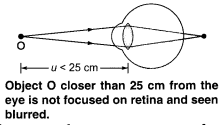In this NCERT Solutions for Class 10 Science Chapter 11 Human Eye and Colourful World we discuss about optical phenomena in nature, rainbow formation, splitting of white light, blue colour of the sky and everything about human eye.
- The Human Eye And The Colourful World
- The Human Eye
- Defects Of Vision And Their Correction
- Refraction Of Light Through A Prism
- Dispersion Of White Light By A Glass Prism
- Atmospheric Refraction
- Scattering Of Light
Checkout previous chapter – NCERT Solutions for Class 10 Science Chapter 10 Light Reflection and Refraction
ALSO CHECK – Download the free Class 10th Notes here
These NCERT Solutions for Class 10 Science Chapter 11 Human Eye and Colourful World is prepared by our best subject experts teachers group thats help students to understand all the topics easily. With the help of these NCERT Solution for Class 10 Science, students can understand the complex topics of class 10 science. We all know Science is a subject that needs a clear understanding of the concepts and topics to score well in it.
Also Check – NCERT Solutions for Class 9 Maths
NCERT Solutions for Class 10 Science Chapter 11 Human Eye and Colourful World In-text Questions
Page no. 190
Question 1
What is meant by power of accommodation of the eye ?
Answer:
The ability of the lens of the eye to adjust its focal length to clearly focus rays coming from distant as well from a near objects on the retina, is known as the power of accommodation of the eye.
Question 2
A person with a myopic eye cannot see objects beyond 1.2 m distinctly. What should be the type of the corrective lens used to restore proper vision ?
Answer:
Concave lens.
Question 3
What is the far point and near point of the human eye with normal vision ?
Answer:
For a human eye with normal vision the far point is at infinity and near point is 25 cm from the eye.
Question 4
A student has difficulty reading the blackboard while sitting in the last row. What could be the defect the child is suffering from ? How can it be corrected?
Answer:
The child is suffering from myopia. The child should use concave lens of suitable focal length.
NCERT Solutions for Class 10 Science Chapter 11 Textbook Chapter End Questions
Page no.- 197
Question 1
The human eye can focus objects at different distances by adjusting the focal length of the eye lens. This is due to
(a) presbyopia
(b) accommodation
(c) near – sightedness
(d) far – sightedness
Answer:
(b) Accommodation
Question 2
The human eye forms the image of an object at its
(a) cornea
(b) iris
(c) pupil
(d) retina
Answer:
(d) Retina
Question 3
The least distance of distinct vision for a young adult with normal vision is about
(a) 25 m
(b) 2.5 cm
(c) 25 cm
(d) 2.5 m
Answer:
(c) 25 cm
Question 4
The change in focal length of an eye lens is caused by the action of the
(a) pupil
(b) retina
(c) ciliary muscles
(d) iris
Answer:
(c) Ciliary muscles
Question 5
A person needs a lens of power -5.5 dioptres for correcting his distant vision. For correcting his near vision he needs a lens of power +1.5 dioptre. What is the focal length of the lens required for correcting (i) distant vision, and (ii) near vision ?
Solution:
(i) ∵ Power of distant viewing part of the lens, P1 = -5.5 D
∴ Focal length of this part, f1 = 1𝑝1 = 1−5.5 m = -0.182 m = -18.2 cm
(ii) For near vision,![]()
Question 6
The far point of a myopic person is 80 cm in front of the eye. What is the nature and power of the lens required to correct the problem ?
Solution:
The remedial lens should make the objects at infinity appear at the far point.
Therefore, for object at infinity, u = ∞
Far point distance of the defected eye, ν = – 80 cm
Negative sign shows that the remedial lens is a concave lens.
Question 7
Make a diagram to show how hypermetropia is corrected. The near point of a hypermetropic eye is 1 m. What is the power of the lens required to correct the defect ? Assume that the near point of the normal eye is 25 cm.
Solution:
(i) The near point N of hypermetropic eye is farther away from the normal near point N.
(ii) In a hypermetropic eye, the image of nearby object lying at normal near point N (at 25 cm) is formed behind the retina.
(iii) Correction of hypermetropia : The convex lens forms a virtual image of the object (lying at normal near point N) at the near point N’ of this eye.
The object placed at 25 cm from the correcting lens must produce a virtual image at 1 m or 100 cm.
Therefore, u = – 25 cm, ν = 100 cm
The positive sign shows that it is a convex lens.
Question 8
Why is a normal eye not able to see clearly the objects placed closer than 25 cm ?
Answer:
At distance less than 25 cm, the ciliary muscles cannot bulge the eye lens any more, the object cannot be focused on the retina and it appears blurred to the eye, as shown in the given figure.
Question 9
What happens to the image distance in the eye when we increase the distance of an object from the eye ?
Answer:
The image is formed on the retina even on increasing the distance of an object from the eye. The eye lens becomes thinner and its focal length increases as the object is moved away from the eye.
Question 10
Why do stars twinkle ?
Answer:
The twinkling of a star is due to atmospheric refraction of starlight. The starlight, on entering the earth’s atmosphere, undergoes refraction continuously before it reaches the earth. The atmospheric refraction occurs in a medium of gradually changing refractive index.
Question 11
Explain why the planets do not twinkle ?
Answer:
Unlike stars, planets don’t twinkle. Stars are so distant that they appear as pinpoints of light in the night sky, even when viewed through a telescope. Since all the light is coming from a single point, its path is highly susceptible to atmospheric interference (i.e. their light is easily diffracted).
Question 12
Why does the sun appear reddish early in the morning ?
Answer:
The light coming from the sun passes through various denser layers of air in the earth’s atmosphere before reaching our eyes near the horizon. Most of the part of blue light and light of small wavelength gets scattered by dust particles near the horizon. So, the light reaching our eyes is of large wavelength. Due to this the sun appears reddish at the time of sunrise and sunset.
Question 13
Why does the sky appear dark instead of blue to an astronaut ?
Answer:
As an astronaut moves away from the atmosphere of earth, the atmosphere becomes thin. Due to the absence of molecules (or dust particles) in air, the scattering of light does not take place. Thus, sky appears dark in the absence of scattering.







